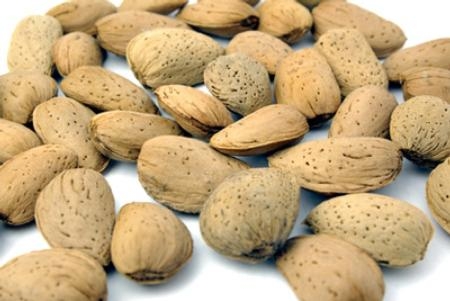- Author: Jeannette E. Warnert

The UCCE citrus and pistachio crops advisor in Kern County, Craig Kallsen, is the UC Cooperative Extension Presidential Chair for Tree Nut Genetics, and UCCE integrated orchard management specialist Bruce Lampinen, based at UC Davis, is the UC Cooperative Extension Presidential Chair for Tree Nut Soil Science and Plant Water Relations. The endowed chairs will give the two scientists a dedicated source of funding for five years, when the chairs are reopened for review.
UC ANR established the two $1 million endowments for the endowed chairs last year. Half the funding was provided by UC President Janet Napolitano; the other half was donated by the California Pistachio Research Board. Establishment of the endowed chairs was announced last year by UC ANR vice president Glenda Humiston.
“I'm pleased that we have identified two exceptional research programs to support with the first endowed chairs in the more than 100-year history of UC Cooperative Extension,” Humiston said. “I feel certain Craig and Bruce will make significant advances in pistachio production systems under California conditions.”
Pistachio breeding program
Kallsen said the endowment comes at a particularly opportune time for the UC pistachio breeding research program. In cooperation with UC Davis pomology researcher Dan Parfitt, Kallsen has been breeding pistachios as part of a variety selection program using conventional methods - manually crossing and then growing trees to determine whether they have beneficial characteristics.
“Breeding new varieties this way takes a while, especially in pistachios,” Kallsen said. “They don't bloom for four or five years. With some trials we are just now at the stage where it gets interesting. The funding will be helpful for evaluating the new progeny.”
Kallsen is looking for pistachio varieties that show novel nut, tree growth and yield characteristics, and for varieties that produce a high yield even under low-chill conditions.
“The climate appears to be warming,” Kallsen said. “That poses a problem for pistachios, because our current cultivars have a significant chilling requirement that has not always been met when we don't have cold, foggy winters.”
Kallsen plans to establish a trial pistachio orchard at the UC Riverside Coachella Valley Agricultural Research Station, where winter weather rarely dips to sufficient chill levels, to see which varieties produce acceptable crops under the warmer conditions.
Another key objective of the UC breeding program is identifying pistachio cultivars that mature at different times. At the moment, 90 percent of California pistachios are the Kerman variety. They all mature at the same time, putting pressure on harvesting, transportation, processing and storage resources.
“Ten years ago, UC introduced the Golden Hills variety, which matures about two weeks earlier. It now represents 5 or 10 percent of the state's crop,” Kallsen said. “We're looking closely at another potential cultivar that matures 10 days before Golden Hills.”
Pistachio research at UC Davis
Lampinen has devoted most of his career to almond and walnut research, but has worked on pistachios in collaboration with other UCCE specialists and advisors since 2009, focusing mainly on canopy light interception and salinity and their impacts on pistachio yield and water use.
Lampinen said his current work on almond and walnut water use as related to canopy size will be expanded to pistachio with the funding from the endowment.
“Some preliminary data on this is currently being gathered, but there is a need to expand this work to a wider range of orchard ages and planting configurations,” Lampinen said. “It will be very useful to have the ongoing support from an endowment.”
Lampinen's work in almonds and walnuts will also inform new pistachio research approaches. For example, Lampinen developed a no-pruning system for establishing new walnut orchards, and will study whether a similar approach in pistachio would make sense. For decades, California farmers believed that pruning young walnut trees was critical to healthy tree development. Lampinen observed unpruned walnut orchards in France, and “they looked perfectly fine,” he said.
Lampinen's research showed that pruning in the early years of tree development reduced water use efficiency and decreased walnut yields. By not pruning young trees, farmers could cut back significantly on labor costs and eliminate the need to dispose of the vegetation cut off the tree while using water more efficiently.
The no-pruning approach is now widely accepted in almonds and walnuts. With funding from the five-year endowment, he plans to compare the impacts of the alternative pruning systems on newly established pistachio orchards.
In addition, Lampinen said he plans to consult with pistachio industry leaders, growers and farm advisors to develop an effective research program on pistachio soil and water relations.
- Author: Jeannette E. Warnert

California almonds are on a roll. In the last 20 years, scientific discovery and grower ingenuity have nearly doubled almond per-acre productivity. A good yield in the 1980s was 1,400 pounds per acre. The average yield for 2011 was 2,670 pounds of shelled almonds per acre.
Forty years ago, California farmers produced less than 100 million pounds of almonds on about 200,000 acres of almond orchards. Mechanization, improved irrigation efficiency, advances in insect and disease management, pruning research and fertilization studies have fueled explosive growth in the industry. Farmers in California’s Central Valley now tend 760,000 acres of almond trees, producing about 2 billion pounds of shelled nuts a year. The crop, which represents 100 percent of U.S. almond production and 75 to 80 percent of world production, was valued in 2011 at $3.87 billion, surpassing table, wine and raisin grapes, which were valued at $3.86 billion.
“Even with this record production, we have more demand than we have supply,” said Bob Curtis of the Almond Board. “The driver behind that is nutrition studies that show almonds are a healthy food and snack.”
A tremendous amount of UC research is behind the California almond success story, said Bruce Lampinen, UC Cooperative Extension specialist in the Department of Plant Sciences at UC Davis, an expert in almond canopy management.
“Higher density plantings of almonds and a trend towards less pruning, and improved water management have led to much higher yields,” Lampinen said.
Many almond growers have replaced flood irrigation with micro-sprinkler or drip irrigation, said Larry Schwankl, UC Cooperative Extension specialist in the Department of Land, Air and Water Resources at UC Davis. These irrigation systems increase the precision of water and fertilizer application. Over the years, UC Cooperative Extension advisors and specialists established demonstrations of micro-sprinkler and drip systems in many parts of the Central Valley and reached out to farmers to show how they could be managed to optimize production.
“Twenty years ago, we simply guessed at the amount of water that the trees needed and we applied it on a calendar basis,” said Joe MacIlvaine, president of Paramount Farming Company in Kern County, one of the state’s largest growers of almonds, pistachios and pomegranates. “Today, we are delivering water and nutrients directly to the root zones when they are needed.”
Two decades ago, a granular form of nitrogen fertilizer was generally applied to almond orchards in the fall to allow winter rain and irrigation to move it into the soil for use by the trees in spring and early summer. Nitrogen use efficiency was believed to be about 40 percent. Now, nitrogen fertilizer is applied through the irrigation system during the growing season, when the tree needs it.
“Today, our nitrogen use efficiency can be as high as 85 percent,” said Blake Sanden, UCCE advisor in Kern County, an irrigation expert. He and Patrick Brown, professor in the Department of Plant Sciences at UC Davis, have conducted nitrogen trials in almonds with Paramount Farming.
“When you increase the conversion of applied nitrogen fertilizer to higher crop yield, there is significantly less potential for nitrogen to leach below the rootzone and contaminate groundwater,” Sanden said. “But each field is unique and requires site-specific management to achieve these high levels of efficiency.”
Another area where UC research has led to significant crop yield growth is in canopy management and tree spacing. Research by Mario Viveros, UCCE advisor emeritus in Kern County, and other scientists showed that a tendency among growers to over prune was taking a toll at harvest time.
“A lot of farmers who are now growing almonds had experience with fresh fruits, where you do need to prune to get light on the fruit for good color. In almonds more canopy generally means more yield,” Lampinen said. “Today, most almond growers only prune when branches are growing in the way of tractors or other equipment.”
UC research also found that orchards planted with traditional wide spacing between the trees weren’t making the most efficient use of sunlight on the farms. Older orchards had 60 to 70 trees per acre. Today, almond orchards are planted at an average density of about 110 trees per acre based on results of UC research.
However, studies have also shown that crowding still more trees into orchards triggers diminishing returns. In almond production, the nuts are shaken from the trees to dry on the ground before they are harvested.
“If the orchard floor becomes too shaded by trees planted too densely, the orchard floor temperature and humidity become optimal for growth of pathogens that could become a food safety problem,” Lampinen said. “You want enough sunlight to hit the orchard floor to reduce potential pathogens, like salmonella.”
MacIlvaine acknowledged the role of UC Cooperative Extension in helping the almond industry achieve the production milestone in 2011.
“The University of California has been a wonderful partner in improving our farming practices,” he said. “The whole system is not only more efficient, but more sustainable at the same time.”
Hear more of MacIlvaine's comments in the video posted below:


